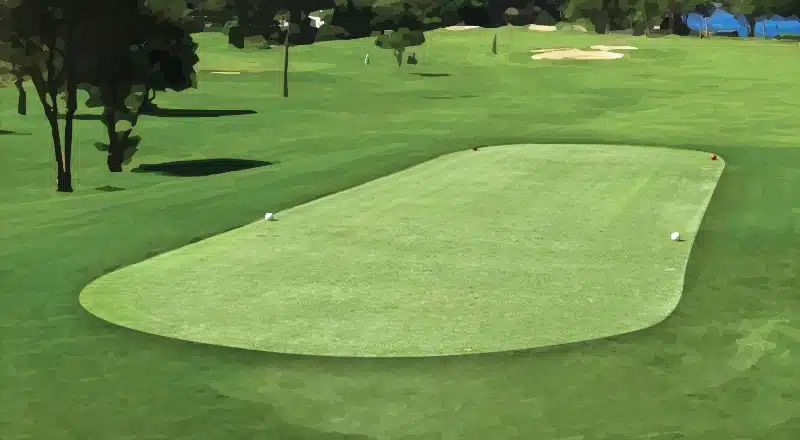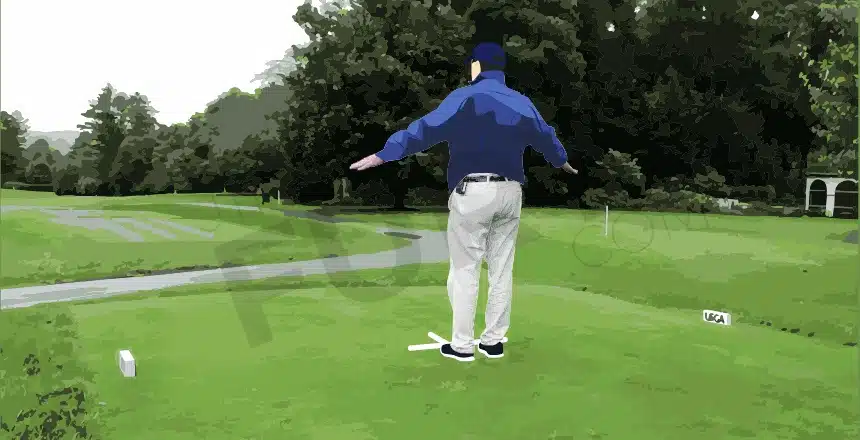All golf courses have different sets of tee boxes, which are designated with a particular set of colored tee markers.
But then what is a tee box in golf to begin with?
How and why does it differ from the teeing area?
What are the different types of tee boxes?
And how do you understand which set to use?
Time to get the right answers to these frequently asked questions!
Related:
In This Post
Tee Box In Golf – What Does It Mean?

Is it just a simple tee box? Nope, try again! Is it the teeing area? Nope, wrong again.
First of all, teeing area and tee box are not the same things, which means you can’t and shouldn’t use the terms interchangeably. The latter, even though a part of the former, has a different definition entirely. The set of rules in both cases also differ.
So what is the tee box in golf? It’s the mown patch of land that consists of tee markers. The boundary of a tee box is determined by the length of the closely cut grass.
And now what is the teeing area? That’s the portion of the turf from where you tee off the golf ball. Tee markers, in this case as well, set their boundaries.
The teeing area takes on a rectangular shape (with the depth of the rectangle being the length of 2 golf clubs). The front-facing edge is established by the 2 tee markers’ forward points. As for the side edges, these take the form of the tee tees’ outside points.
Hence, teeing your golf ball up can be done from the forward-most points i.e. front edge of those markers to the length of 2 clubs at the back. It’s supposed to be within the well-defined width of the tees.
Tee Box In Golf – Its Origin and Usefulness
The very first stroke you take on every hole is hit from the tee box. The area is commonly referred to as the “tee box” or “teeing ground” (the latter term was used up until 2019).
It’s where you start playing each hole during your round of golf. The place is noticeably covered by the distance or space between 2 tee markers, along with a depth of 2 golf club lengths from the markers.
The USGA and R&A, the two official governing bodies of golf, refer to the tee box as the “teeing area.” So why do we golfers call it the “tee box”?
Back in the day, there were no wooden tees, so how players used to tee up the golf ball was they would place the ball over a small stack or mound of damp sand. This wet sand was available inside the boxes, arranged properly on every teeing ground. Hence, the term “tee box.”
The tee box exactly describes a set of tee markers and the teeing area also specifically refers to a set of tees. Just that with a tee box, this particular term includes the teeing area of each hole.
Golf courses have varying numbers of tee sets – 3, 4, 5, and higher. This paves the way for different yardages. More often than not, these types of teeing areas, for the sake of better clarity and convenience, are grouped en masse. So the term “tee box” involves the reference to the grouping of the teeing areas as well.
But the official governing bodies of golf use the terms interchangeably, but mostly it’s called the “teeing area.”
Different Tee Boxes In Golf
It’s only common to come across golf courses with multiple tee boxes grouped. Each set has its own colored tee markers. Typically, at least 3 sets are in place – forward, middle, and back tees. However, it’s not uncommon to visit a golf course with more sets of tee boxes, such as 5, 6, or even 7. In that case, you might wonder which tees should I play?
Every tee box corresponds to a particular yardage, so that means varying playing abilities. Meaning the ones behind the tee box are the longest while those in the front are the shortest. Just find out what the yardages are by taking a look at the scorecard. What are the blue tees in golf? Answer: Blue tees will be marked by a blue line, and so on.
With more exposure to the game of golf and over time, you’ll automatically know what tees you have to use. Those finding it difficult to play from a certain set of tees, for example, those struggling with reaching a par-3 hole from the tee or par-4 in just two shots should consider playing from the shorter, hence easier set.
- Back tees, which are long-distance tees, are mainly for low-handicap, more advanced players.
- Forward or shorter tees are for high-handicap, beginner, senior, and mostly women golfers.
- As for the middle tees, these are for mid-to-high or mid-to-low handicap players. Or for long-hitting golfers – men or women, young or senior.
The Teeing Area According to the Rules of Golf
You can’t tee off from beyond the set boundaries of the teeing area. So what are the rules you need to know about the golf tee box markers and teeing area?
- You start your every hole from the often raised tee box. USGA tee box rules precisely state that the teeing area consists of the rectangle-shaped depth of 2 golf clubs’ length, with the front and outer edges being the forward-most points and outer-most sides of tee markers.
- As for the golf club length taken into consideration for the depth of the teeing area, based on the official rules, the length is the length of the longest golf club you have in your bag (except for the putter).
- Being inside the teeing area is important but you also have to be careful about the distance you cover at the back for avoiding a certain patch of the turf (probably because it’s uneven or for achieving exact yardage in the case of par-3). This becomes even more crucial if you decided that you didn’t want to carry your misbehaving golf driver that particular day.
- Speaking of drivers misbehaving, you may want to check out our top-rated drivers that know not how to misbehave at all because they’ve been specifically engineered to boost distance. Even some TaylorMade drivers are superb when it comes to driving your shots straight and long. As long as you know how to hit a driver, you’re all set!
- Moving on, what if the ball, the smallest part of it, goes over the edge of the teeing area? It’s still counted as remaining inside the area. Thus, it’s officially allowed for you to step out of that teeing area provided that your golf ball is inside it. A very effective strategy for maximizing the angle of the hole or being able to score a certain type of shot more comfortably (meaning better shot-shaping capabilities).
- But what’s the penalty if you don’t play from within the teeing area? Or maybe you play from simply the wrong tee? The former occurs due to a lack of focus where the markers have been set widely apart from each other, hence you end up a little in front of them.
- The penalties here are different for match play and stroke play. Match play involves no penalty as such, except that the opponent will request you to cancel out that stroke and hit another one from inside the teeing area. But then it also depends on how you hit the original shot. If the golf ball is knocked close on par-3, only then you can replay.
- As for stroke play, a general penalty is applied, which means you earn two strokes and after that, you correct the mistake by teeing off from within the boundaries of the teeing area before your next stroke. Failing to do so will have you disqualified. And if it’s the final hole, then you must right the wrong before you return to the scorecard.
- What about when you play from an incorrect tee? Now, this is much less likely to happen. However, whenever it does, it’s mainly because of teeing off absentmindedly from the yellow tee box golf markers when the golf round is played from whites. Or maybe, as a result of the tees set very close together (on unfamiliar courses).
- And lastly, if the golf ball ends up in a teeing area of a hole you’re in the process of playing, you must tee again from within that particular teeing area. Just what you need in case you have to hit a pretty long shot over a hazard or obstacle!
Conclusion
It’s simple to understand – teeing area consists of a certain shape and size with the depth being as long as the length of 2 golf clubs. It has a rectangular shape and is the point from where you begin playing your each hole.
There’s a difference between teeing area and tee box. In this article, I’ve explained the differences between the two and even explained what each term means and entails. So I hope the whole topic of tee box in golf, different tee boxes in golf, and more is less confusing to you now!

